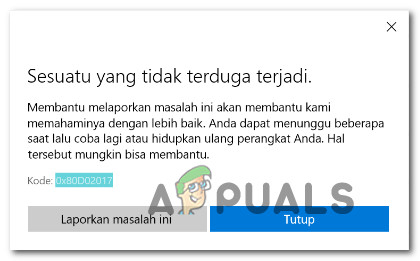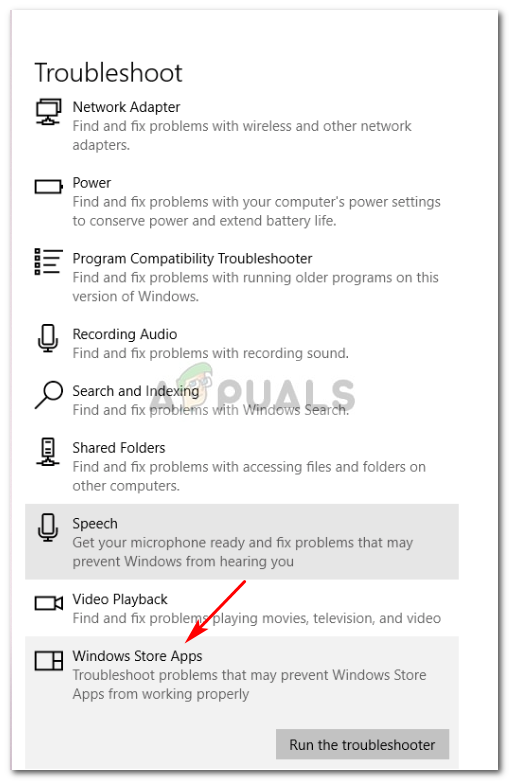What is causing the 0x80d02017 Error Code inside the Windows Store?
We investigated this particular issue by looking at various user reports and the repair strategies that are commonly being used to fix this issue on Windows 10 computers. As it turns out, there are several different potential culprits that can be responsible for the manifestation of this error code: If you’re currently struggling to resolve the very same error message when trying to access an application using the Windows Store, this article will provide you with several different troubleshooting steps that should mitigate the issue. Down below, you’ll find several different potential fixes that other users in a similar situation have successfully used to resolve the 0x80d02017 error code. If you want to remain as efficient as possible, we advise you to follow the methods in the order that they are presented since we ordered by efficiency and severity. Regardless of the culprit that is responsible for the issue, you should eventually stumble upon a method that will help you get around the issue and use the application normally. Let’s begin!
Run the Windows Apps Troubleshooter
Before you try any other time-consuming fixes, let’s see if your Windows version is not perfectly capable of resolving the issue automatically. All recent Windows versions are equipped with new and improved versions of the classic troubleshooter that will automatically scan various Windows components for inconsistencies and automatically apply the appropriate repair strategy. If the culprit behind the 0x80d02017 error code is covered by one of the repair strategies included for the troubleshooter, you will be able to resolve the issue automatically simply by running the Windows Apps troubleshooter. Here’s a quick guide on running the Windows apps troubleshooter to resolve the 0x80d02017 error code: If the same 0x80d02017 error code is still occurring, move down to the next method below.
Use Powershell to reset the Windows Store app
If your particular issue is being caused by some type of corruption among the Windows store’s files, you should be able to resolve the issue quite effectively by running a Powershell command capable of resetting the entire Windows Store package. This might make you lose some user preferences, but it’s one of the quickest and most effective fixes that you can implement using a Powershell terminal. Several affected users have reported that the issue was no longer occurring after following the steps below and restarting their computers. Here’s a quick guide with how to reset the Windows Store app using a Powershell prompt: If the same issue is still occurring when you try to download or launch an app via Windows Store, move down to the next method below.
Uninstall 3rd Party Firewall or VPN
As it turns out, VPN or 3rd party firewall clients have the potential of inhibiting Windows Store’s ability to download and launch new applications. This happens because your private connection is not trusted by the Windows installation agent, so the process is being stopped by a security function. If this scenario applies to your current situation, you will be able to resolve the issue by uninstalling whatever proxy server, 3rd party Firewall, or VPN client that you’re using. This will make the installation agent trust your connections and should allow the application to open without any problem. Here’s a quick guide on uninstalling the 3rd party firewall or VPN: If the same 0x80d02017 error code is still occurring or this method wasn’t applicable, move down to the next method below.
Disable IPV6 support
This method has the potential of creating additional incompatibilities with your computer (with other applications that make use of IPV6), but it’s still one of the most efficient ways of resolving the 0x80d02017 error. Although there’s no official explanation on why disabling IPV6 support ended up resolving the issue for a lot of users, users are speculating that it’s probably because Windows Store has the potential of glitching when a dynamic IP configuration is being used. This procedure might reduce the download & upload speed for a bit, but the workload should be passed over to the IPV4 protocol. Here’s a quick guide on disabling IPV6 support: If the same issue is still occurring or you’re looking for a method that doesn’t involve disabling an Internet Protocol, move down to the next method below.
Reset the software distribution folder
As it turns out, this particular issue can also occur if you’re dealing with a corrupted software distribution folder. Several users in a similar situation have reported that the issue was resolved after they ended up resetting the software distribution folder. But keep in mind that before you follow the steps below, you need to ensure that you disconnect your computer from the internet – turn off your Wi-Fi or physically disconnect the wired connection. If you fail to do this, Windows 10 will signal that some files can’t be modified and the command will not be successful. Once you’ve ensured that the internet connection is disabled, follow the instructions below to reset the software distribution folder:
How to Fix Windows 10 Store Error Code 0x80240437How to Fix Windows Store Error Code 0x803FB107[FIX] iTunes Store Error Code 0x80092013 on WindowsHow to Fix ‘Error Code: 0x803FB005’ on Windows Store







